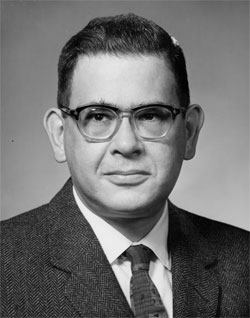April 1, 1948: The Origin of Chemical Elements
 Photo: AIP Ralph Alpher |
Physicist George Gamow was born in Odessa (now in Ukraine), in 1904. He grew dissatisfied with the Soviet Union, and after one failed attempt, he fled and immigrated to the United States in 1934. He took a position at George Washington University in Washington, DC.
In the early 1940s, Gamow was working on explaining the observed abundances of elements. It had already been shown that in the cores of stars, hydrogen nuclei fuse to form helium. But this process happens too slowly to account for the observed abundance of helium in the universe (about 1 atom of helium for every 10 atoms of hydrogen) and it didn’t account for the existence of elements much heavier than helium. Gamow wondered if the conditions of the very early universe could have produced the observed helium and other elements.
The research needed knowledge of nuclear physics, but most nuclear physicists in the US at the time had been recruited to the Manhattan project, so Gamow was essentially alone in working on the problem of nucleosynthesis.
He started making calculations, beginning by looking at the density of matter in the universe and essentially running the expansion of the universe backwards to get an estimate of what the early universe might have looked like. He then began trying to figure out the probabilities of nuclear reactions in early universe. As the universe expands, conditions constantly change, so the calculations were complicated. Not particularly adept at mathematical calculations himself, Gamow recruited PhD student Ralph Alpher to help.
They started by imagining the early stage of the universe as an extremely hot dense gas of neutrons, (which they called “ylem,” after a medieval word for matter). As the universe expanded, the hot compressed neutrons would decay into a mixture of protons and electrons and neutrinos. Then the protons would capture some of the remaining neutrons to form deuterium. Further neutron capture would build up heavier and heavier atomic nuclei. The process would continue as the universe expanded until it was too cool for further reactions to take place.
Alpher’s calculations of nuclear processes used some of the first electronic digital computers, which had been developed during World War II. He was also able to use new data on nuclear reaction cross sections that had become available after the war ended.
The calculations agreed with the known abundance of helium. Pleased with their result, Alpher and Gamow submitted a brief communication to the Physical Review, titled “The Origin of Chemical Elements.” They celebrated with a bottle of liqueur, which Gamow relabeled “ylem.”
Gamow, who was known for his sense of humor, saw that the paper they had submitted to Phys. Rev. was to appear on April 1, 1948. He added the name of his friend Hans Bethe, who was known for work on nuclear reactions in stars, among other things, to the paper, so the authors would be Alpher, Bethe, and Gamow, a pun on the first three letters of the Greek alphabet.
Alpher, as a PhD student struggling to make a name for himself, objected to the addition, fearing that the name of the famous Bethe would overshadow his own, reducing the credit he received for his crucial contribution to an important piece of research. But Gamow published it with Bethe’s name, despite Alpher’s objections.
The paper, still known as the alpha-beta-gamma paper, not only explained the origin of the most abundant elements in the universe, but also provided the first support for the big bang model since Hubble’s discovery in 1929 that distant galaxies are redshifted in proportion to their distance from us.
It later became clear that most elements actually cannot be produced by the successive neutron capture process Alpher and Gamow originally proposed because there is no stable nucleus with 5 nucleons. Another process was needed to bridge the gap to create heavier elements. The Alpher-Bethe-Gamow theory does, however, correctly explain the abundances of hydrogen and helium, which together account for more than 99 percent of the baryonic matter in the universe.
Following the publication, Alpher still had to complete his PhD. Scientists and the press heard about the Alpher-Bethe-Gamow result, and 300 people crowded in to hear Alpher’s thesis defense at George Washington University in the spring of 1948. The Washington Post, hearing Alpher’s statement that the creation of hydrogen and helium in the hot big bang took just 300 seconds, boldly reported that the “World Began in Five Minutes.”
Alpher was awarded his PhD, but his 15 minutes of fame soon ended. After finishing his PhD, he and Robert Herman (who resisted Gamow’s efforts to get him to change his name to Delter) continued work on the early universe. That research led them to predict the cosmic microwave background, but their prediction was ignored, and they were not given credit when the CMB was discovered in 1964. Alpher later became a researcher at General Electric. Gamow went on to study other topics as well, dabbling in the chemistry of DNA. Alpher died in 2007, shortly after receiving the National Medal of Science.
©1995 - 2024, AMERICAN PHYSICAL SOCIETY
APS encourages the redistribution of the materials included in this newspaper provided that attribution to the source is noted and the materials are not truncated or changed.
Contributing Editor: Jennifer Ouellette
Staff Writer: Ernie Tretkoff
April 2008 (Volume 17, Number 4)
Articles in this Issue

